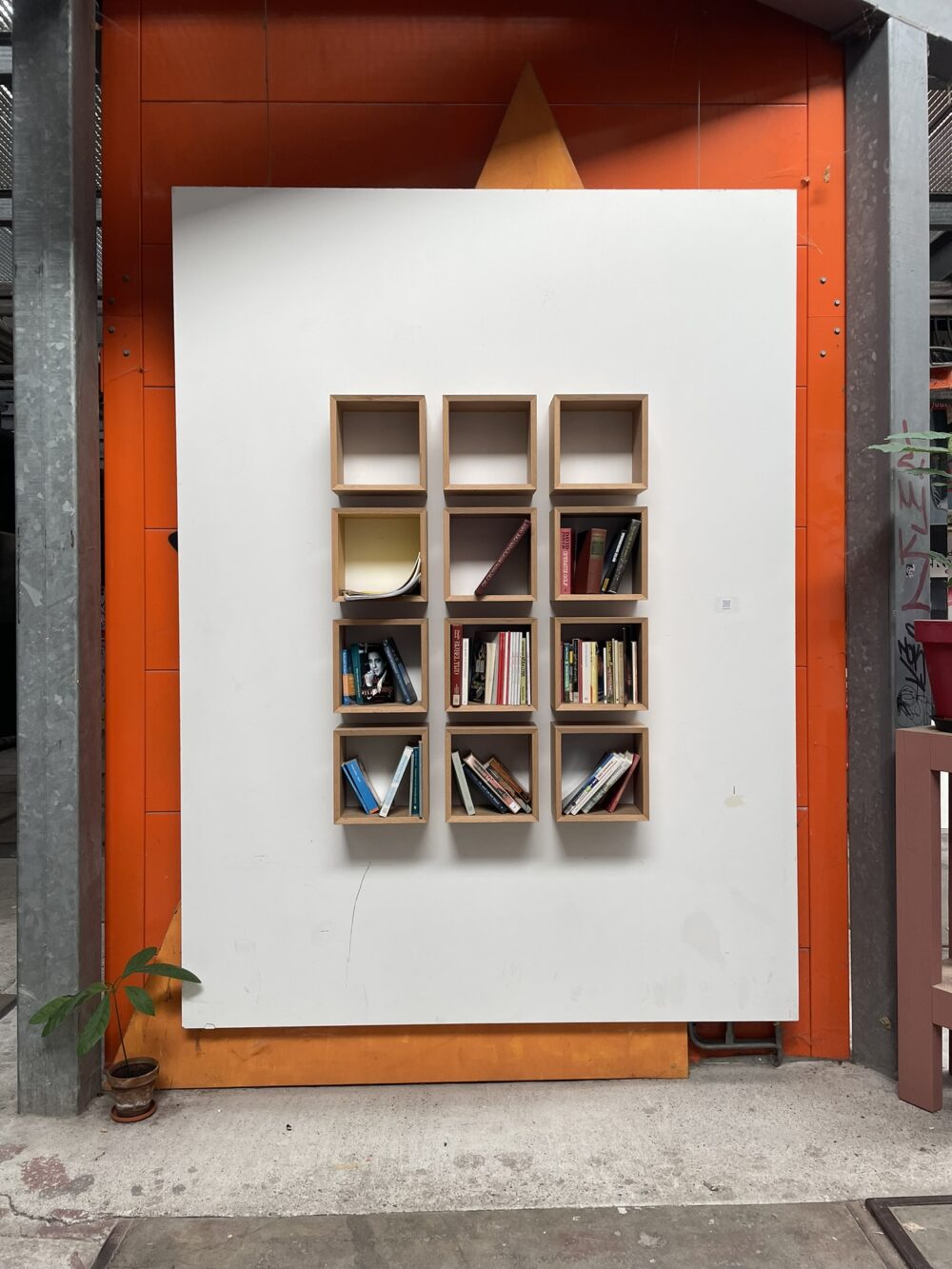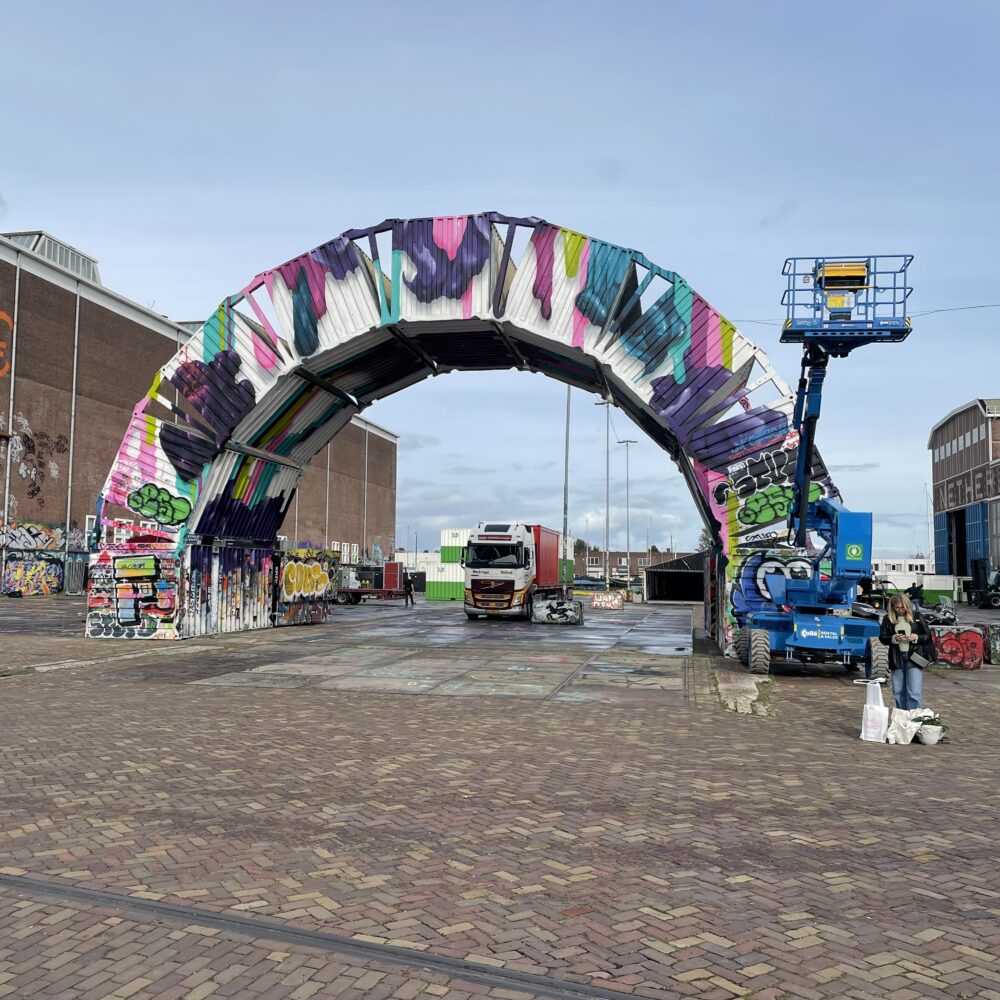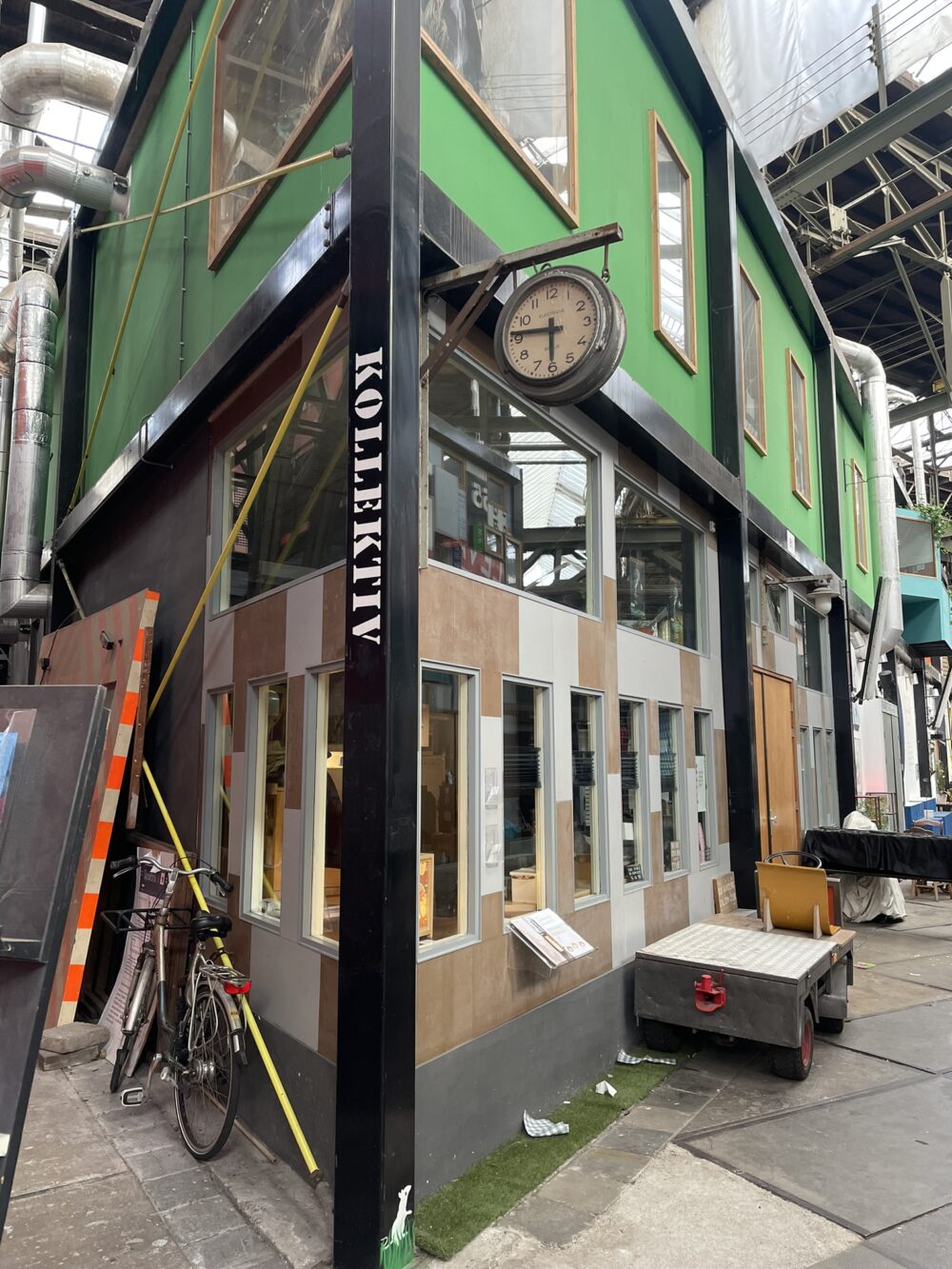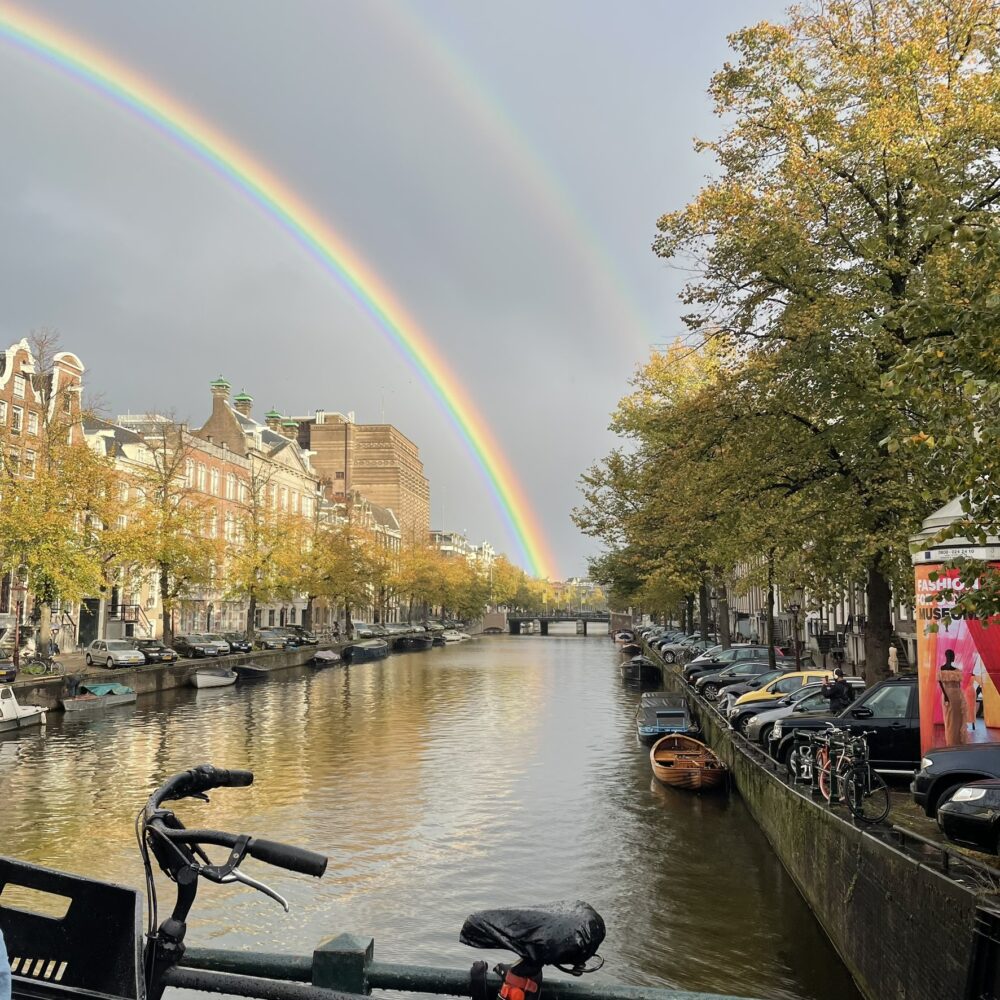
I’ve been to see ‘Longing for Nature’
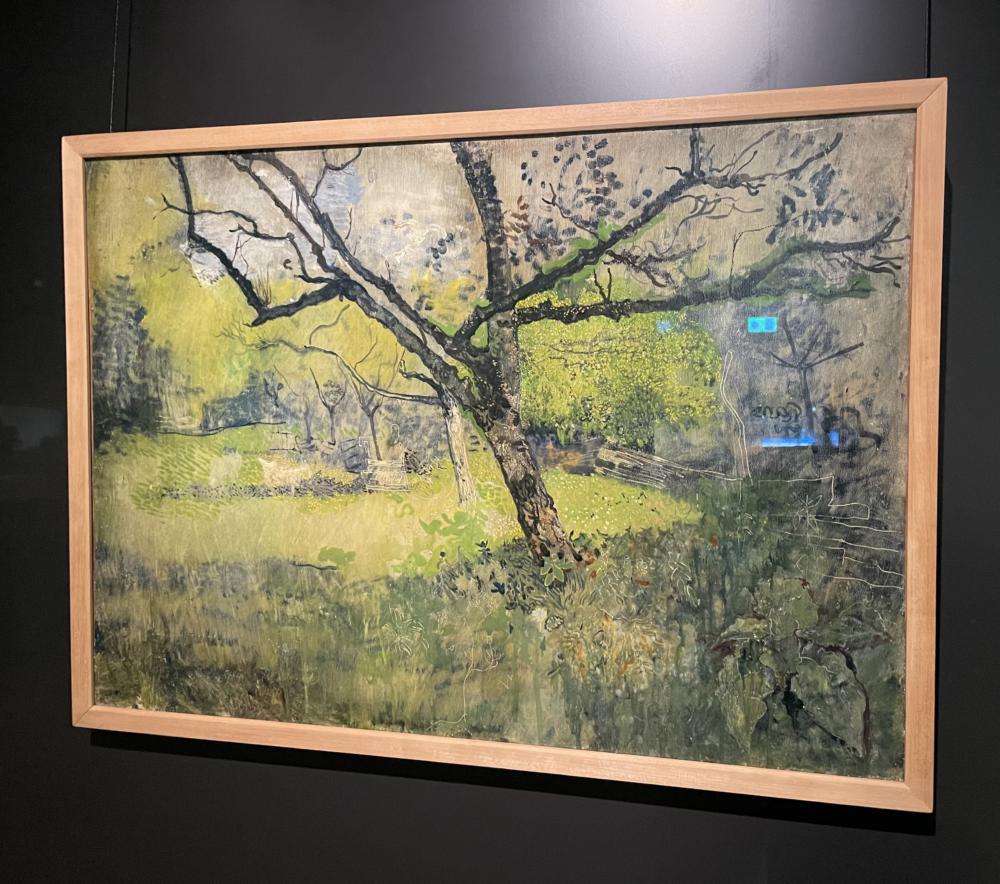
Whenever I’m at Schiphol, provided I’m in the non-Schengen zone, I try to make time to pop into the tiny branch of the Rijksmuseum. The current exhibition is ‘Longing for Nature’, and I thought it made quite a nice partner to the ‘Essence of Nature’ exhibition I saw at The Laing earlier this summer.
Whereas ‘Essence of Nature’ was about the changing artistic representations of nature, ‘Longing for Nature’ is about the shifting relationship between humankind and the natural world. The exhibition focuses on the 19th century, which was a period of immense change in this relationship. The exhibition posits that, in the early 19th century, nature was considered indestructible and immutable. The Industrial Revolution clearly challenged that perception.
I think that’s a hard case to demonstrate with such a small exhibition. Yet, I was struck by this painting: Orchard at Eemnes by Richard Roland Holst. From ‘Essence of Nature’ I’d learned about how art moved from aiming to be photorealistic in the pre-Raphaelite era to being more about character and atmosphere later on. Seeing this in the context of ‘Longing for Nature’ made me realise that the latter is filtering the scene through the human experience.
Just as popular perception shifts from nature being immutable to humans having an impact, we also started to consider nature in art through the human experience, rather than appreciating its essential quality. That surely can’t be coincidental.
‘Essence of Nature’ continues at The Laing until 14 October.
This post was filed under: Art, Post-a-day 2023, Travel, Amsterdam, Richard Roland Holst, Rijksmuseum, Schiphol, The Laing.
I’ve visited Amsterdam’s Van Gogh Museum
I’ve been to Amsterdam a few times, but never visited the top museum (as rated by TripAdvisor). I’ve always struggled to get past the fact that it seems like a tourist trap. I know consciously that it isn’t: I’m sure I’ve read a Sunday newspaper article or suchlike at some point which gave the history and set out the Dutch state’s involvement, and I’m sure I’ve heard of its research work. But still, there is something about it that screams ‘tourist attraction’ more than ‘art gallery.’ Anyway, I got over myself and bought a ticket.
What I didn’t realise before visiting is quite how many Van Gogh paintings are in existence: he was certainly a prolific fellow. And perhaps visiting the Van Gogh Museum isn’t really the best time to realise that you’re not really into his style of painting. I can enjoy a bit of impressionism, and I can enjoy a bit of naturalism, but Van Gogh’s is a stopping point on the post-impressionism journey that doesn’t do much for me. It’s too structured to make me feel the wonder that impressionism can bring, and too unstructured to make me feel the awe of naturalism.
As I wandered the museum, I found in each gallery that my eye was taken first by the works of other artists, provided for context. This is probably partly a function of the museum being full of Van Gogh paintings, and the different things standing out, but it’s also because Van Gogh’s work leaves me a bit cold. I wouldn’t really want it on my walls (though I wouldn’t mind it in my bank, especially after his eponymous museum charged me €5 for a less-than-delicious latte).
This isn’t completely true. There were two works I enjoyed, though I was tickled to note that both were from the period after Van Gogh went mad.
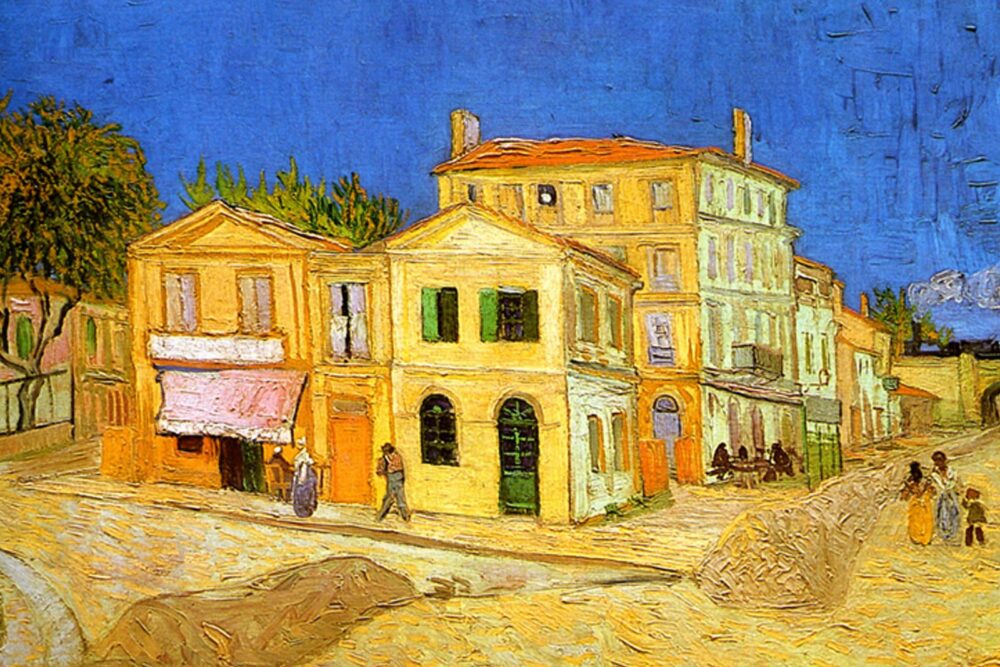
The Yellow House from 1888 had enough life and mystery to draw me in for a few minutes. The depth off to the right intrigued me, as did the people outside what I took to be a restaurant. I lost interest slightly when I found this to be a painting of a real place rather than a more imaginative work.
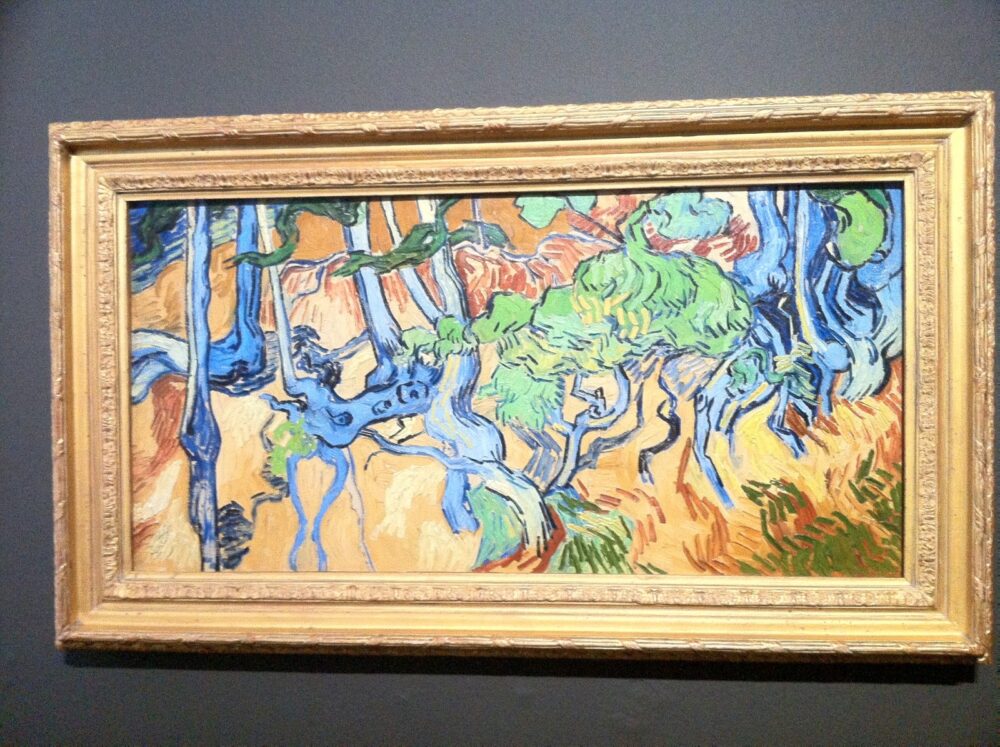
Tree Roots from 1890, reputed to be Van Gogh’s last painting, was far and away my favourite. I love the abstract nature combined with the bright colour scheme. You really could see anything in it, and it invites contemplation.
Unlike The Yellow House, the interpretive text here only deepened my appreciation: it made the point that in his earlier studies of tree roots, he told his brother that he would like to use the subject to express life’s sorrows. The slightly unimaginative curators suggest that he must have moved on from this interpretation given his bright use of colour, but I wondered whether it was a vaguely Stoic commentary on the joy of life being found in the struggle. With that interpretation, I’d have no hesitation putting this one on my wall: but I’ll still pass on all those self-portraits and not-quite-abstract-enough landscapes, thanks.
This post was filed under: Art, Post-a-day 2023, Travel, Amsterdam, Van Gogh.
I’ve been to see ‘Irma Boom: Art + Books’
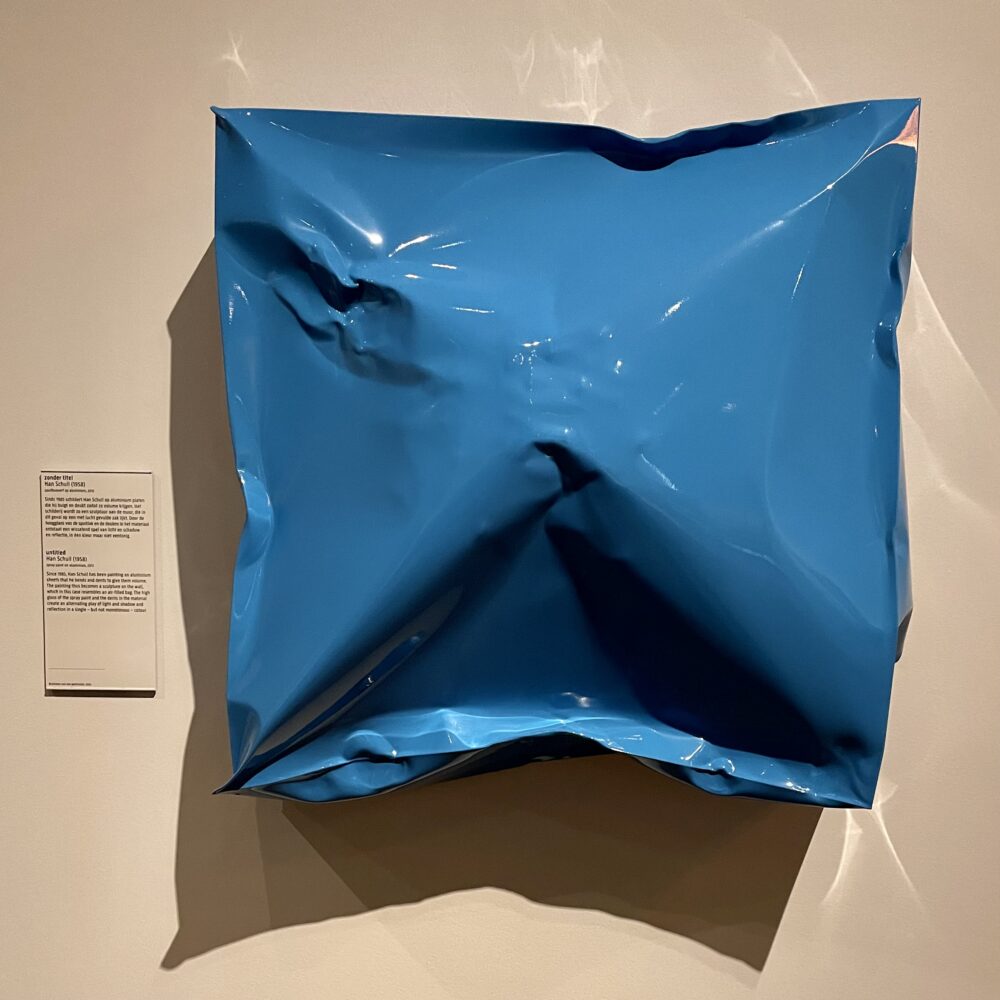
I can’t claim to have a deep or long-standing appreciation for the work of Irma Boom, but I think like most of us, I had a vague familiarity with the name and was aware that she was a designer. Having visited this exhibition, I’m much more familiar with her work designing books, and also her work in designing the visual identify of the Rijksmuseum following its 2013 refurbishment.1
Having said that, I don’t think this exhibition was massively successful. Boom’s entire philosophy, as described in the exhibition, is that books can be turned into powerful works of art because they involve a necessary order and narrative. This is not well demonstrated by sticking the book in a glass case, where the viewer can see only one part of it.2
It also wasn’t massively clear where Boom’s exhibition started and ended. We were told that she had selected some works by others to theme with her own. However, Boom’s works were together in a corner of a gallery, and I’m not certain how much of the other stuff in the room was Boom’s doing, and how much was just permanent collection stuff.
For example, I was particularly taken with Han Schull’s untitled work pictured at the top of this post: a bit of aluminium spray-painted in a single colour and then duffed up, meaning that it looks like there are many colours (or shades) to it, even though in another sense there is only one. I can see the obvious connection between that and bookmaking… but did Boom see that connection, or has the Schull work lived long on that wall?
I was particularly intrigued by two of Boom’s books.
Her book for Chanel No5 which was ‘printed’ without ink was inspired. The texts and images are embossed rather than printed, meaning that the whole book remains plain white. This was a commentary by Boom on the way that the perfume, too, is experienced through senses besides the visual.
Her SHV Think Book was also striking, less for the object itself than for part of the story behind it. SHV had wanted the ‘book’ to be a permanent record, and so had considered creating a CD-ROM—the then-latest technology—rather than a book. Boom advised otherwise, suggesting that a book was likely to be a more timeless option than any modern digital format, and she won out. In retrospect, Boom was obviously correct: in 2023, a book is clearly much more accessible than a CD-ROM. This struck me because I’ve had this same conversation several times, especially with web developers. I once had to explain in terms that one of the major functions of something I was writing was for it to sit on a shelf alongside 100+ older versions—this wasn’t an optional extra.
Finally, there was a bit of what might reasonably be called surrealism to tickle my fancy. As part of Boom’s design work for the Rijksmuseum, she designed the object labels, one of which became an object in this exhibition as a result. And, as if that weren’t enough, from the ceiling hung a Benno Wissing and Jan Hoogervorst design for a directional sign to a toilet, as used in Schiphol Airport. There was no toilet in the indicated direction, of course, for this sign had been re-designated as art. Sublime.
Irma Boom: Art + Books continues at the Rijksmuseum until 7 May.
- Including, as it happens, that expensive Vermeer catalogue I mentioned. ↩
- It’s not long since I got frustrated at the same thing in the British Library exhibition of Alexander the Great, so forgive me if you think you’ve heard this rant before. ↩
This post was filed under: Art, Post-a-day 2023, Travel, Amsterdam, Irma Boom, Rijksmuseum.
I’ve travelled from Newcastle to Amsterdam by train
I recently had occasion to travel from Newcastle to Amsterdam. This is a journey I’ve taken a few times in the past, sometimes by DFDS ferry and sometimes flying with KLM.
This time, I decided to take the train.
My options were limited.
I couldn’t travel with DFDS as my trip fell during one of their ship’s maintenance periods, meaning that departures were occurring only ever other day.
I could have taken a direct flight with KLM. This would have departed at 0925 and arrived at 1125. The snag was that the economy fare was quoting at £391, which I baulked at.
I could have taken an indirect flight with BA. This would have departed at 0940 and arrived at 1925, with a six-hour layover at Heathrow. I’m not averse to a long layover when the price is right, but at £334 in economy, it wasn’t.
I could have taken a train down to King’s Cross with Lumo (£50) and a Eurostar from St Pancras (£172), which at £222 is a pretty hefty saving over the aerial options.
And the latter is almost what I did, except I decided to take a seat in LNER first class to King’s Cross (£100), break my journey in London for a few hours, and book myself into Eurostar standard premier (£229). At £329, the upgraded train journey still undercut economy flights, and it would be much less environmentally damaging.

The best thing to be said about travelling by train is that it’s better than being on a coach.
In the years when I did it more often, the best thing about taking a first class morning seat from Newcastle to King’s Cross was the breakfast: the trolley of fresh pastries, the yoghurts, and most of all the delicious porridge with honey. Porridge is something I eat almost exclusively on trains.
These days, it seems the service has paled a little. There were no pastries on my train. Yoghurt was offered only as an alternative to a hot option. And the porridge was served not with honey, but with maple syrup. What has the world come to?
On the upside, the green tea wasn’t bad, which is high praise indeed, for most green tea served on modes of transport is borderline undrinkable (though substantially better than the typically stewed black tea or coffee). On BA, green tea always involves an extensive rummage in the galley, as though there might be a tea bag somewhere in the back of a tray, possibly first loaded in 1994.
When I made this journey with Lumo a few weeks ago, I noted that they were strict with seat reservations, and I attributed this to their “LumoEats” service. However, for the first time in all the years I’ve been travelling on LNER and its predecessors, the staff on this service were also militant about reservations, even in first class. When tickets were checked, passengers sitting in seats apart from those they had reserved were politely asked to move.
I approve, even though this did screw up the food orders for those who had placed them before the ticket check took place. They won’t make that mistake again, one hopes.
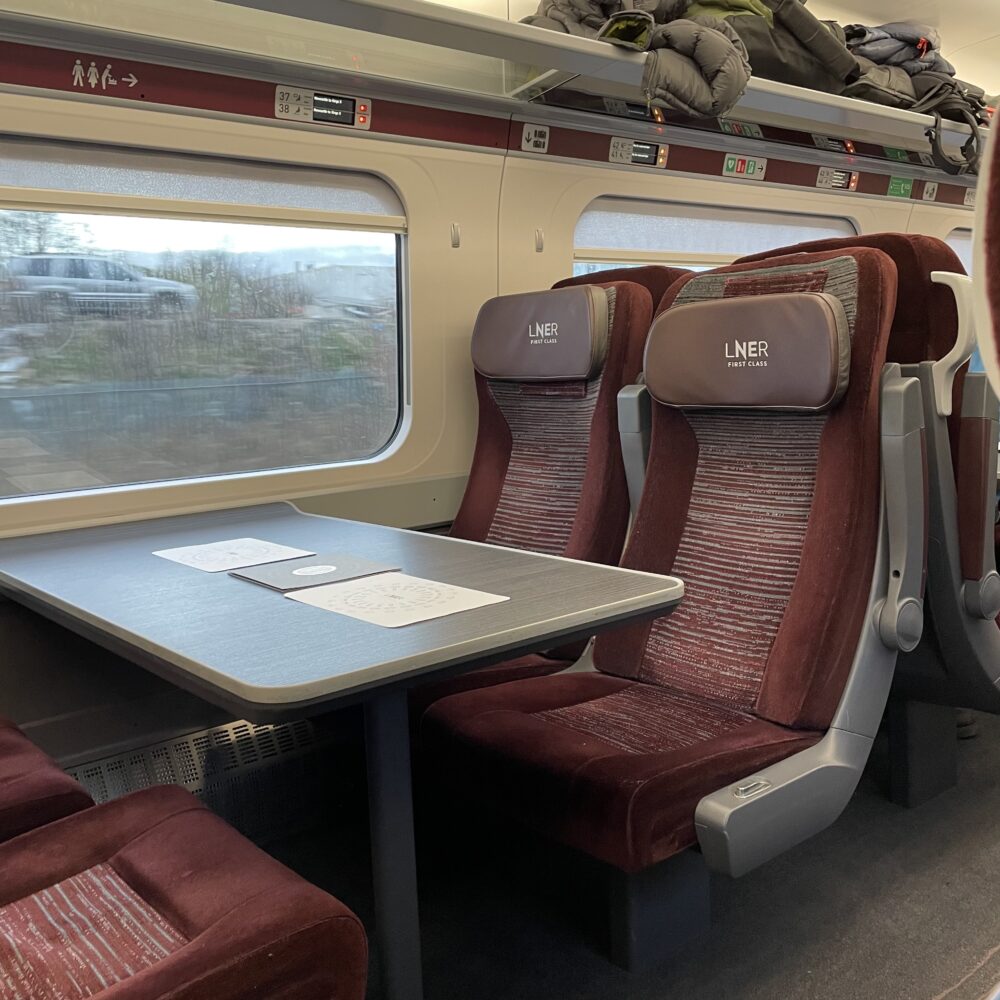
The age of Zoom means that the First Class quiet carriage is more missed than ever.
Along with many more important things in Britain, Brexit has ruined the Eurostar station experience—at least at St Pancras. The combined security screen and passport checks used to be so quick as to be negligible. With passport stamping and suchlike now required, it took the better part of 35 minutes to get from the station concourse to Eurostar departures.
I suppose receiving a ‘Londres’ stamp from French border agents is novel, at least.
The Eurostar train staff make all their PA announcement in three languages. I know this is common all over the world, but on British soil it makes my personal inadequacy in speaking only English feel even more acute.
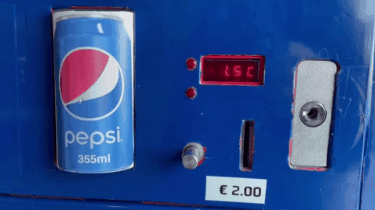
This was my first journey on one of Eurostar’s newish e320 trains, having always been on e300 trains before. I couldn’t really tell you the difference.
The seats were comfy enough, the stewards kept plying me with free alcohol, there was a socket to charge devices, and we sped along through the UK, France, Brussels, and The Netherlands at nearly 200mph. Even the free wifi was alright. All Eurostar trains are a little wider than standard British trains, so they immediately feel comparatively spacious.
As with all Eurostar journeys, the best bit was arriving in the centre of Amsterdam, a stone’s throw from my hotel, and moseying out of the station: no need to worry about passport checks, baggage reclaim, taxis or transfers.
Bliss.
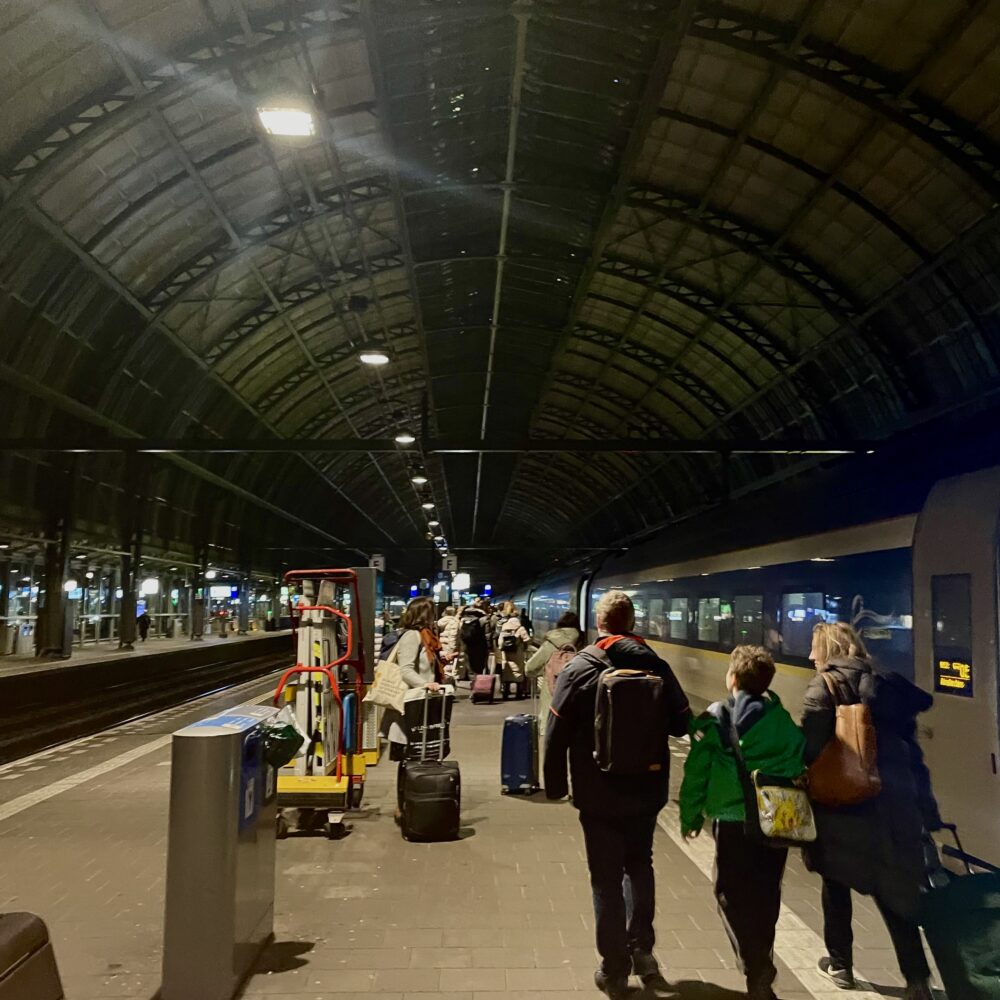
So, having travelled to Amsterdam by train, plane, and ship, a good blogger would plump for one of the three and say they’ll always travel that way from now on. But not me.
I’d have no hesitation in hopping on the train again when circumstances allow, but that isn’t going to work for a day trip.
The ferry is nice for travelling while asleep and saving on a night’s accommodation, but there’s only one sailing per day, so the timing has to work out, and the carbon footprint isn’t exactly exemplary.
And the plane’s fastest, but it’s also often expensive, and comes with a dose of flygskam.
So… it’s horses for courses, innit.
This post was filed under: Post-a-day 2023, Travel, What I've Been Reading, Amsterdam, Eurostar, LNER.
I’ve been to see ‘Vermeer’
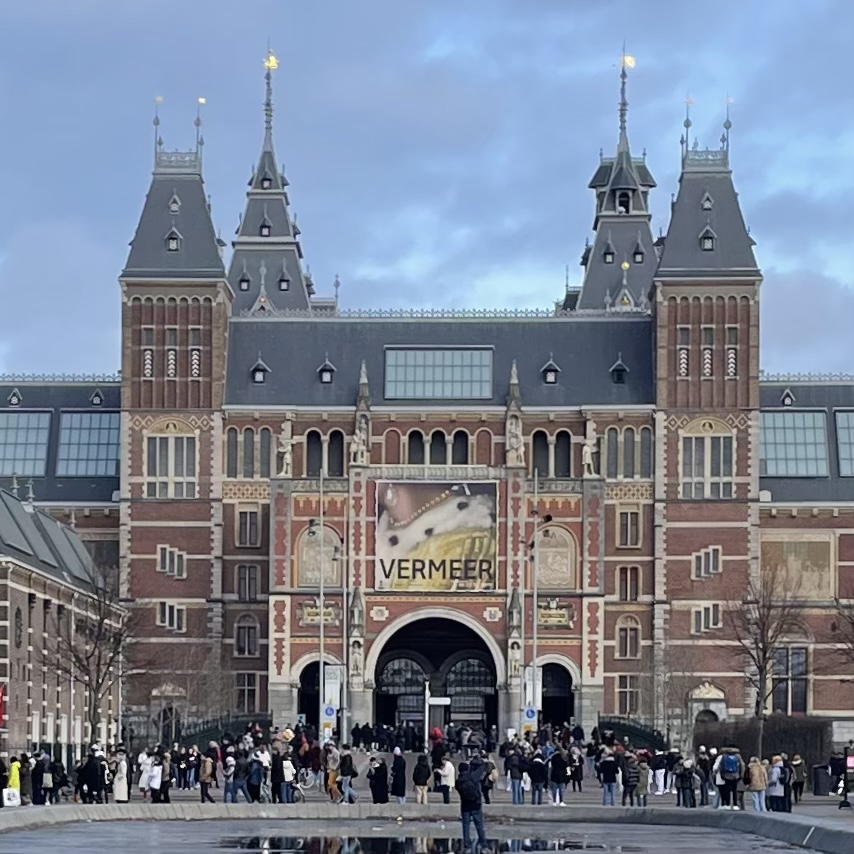
There are 37 paintings by Johannes Vermeer in this world, and the Rijksmuseum—for the first, and very possibly last, time in history—has gathered 28 of them in a single exhibition.1 I was lucky enough to go for a gander. And I mean lucky, because with over 200,000 tickets sold, this exhibition is sold out for months.
You’ll probably gather from the photos that I went into this exhibition with a slight sneer: here was an opportunity to see some pictures that are already familiar while peering over people’s shoulders and through their mobile phone screens. I’m not a fan of the sort of literal representative art that makes up Vermeer’s oeuvre. I was going as much to say I’d been as to actually see anything.
I’ve been lucky enough in my life to see any number of fantastically famous artworks, from the Mona Lisa to the Sistine Chapel. And every single time, it has looked just about exactly as I already knew it looked, and I felt no different for having seen it than I did beforehand. I wondered why I bothered.2
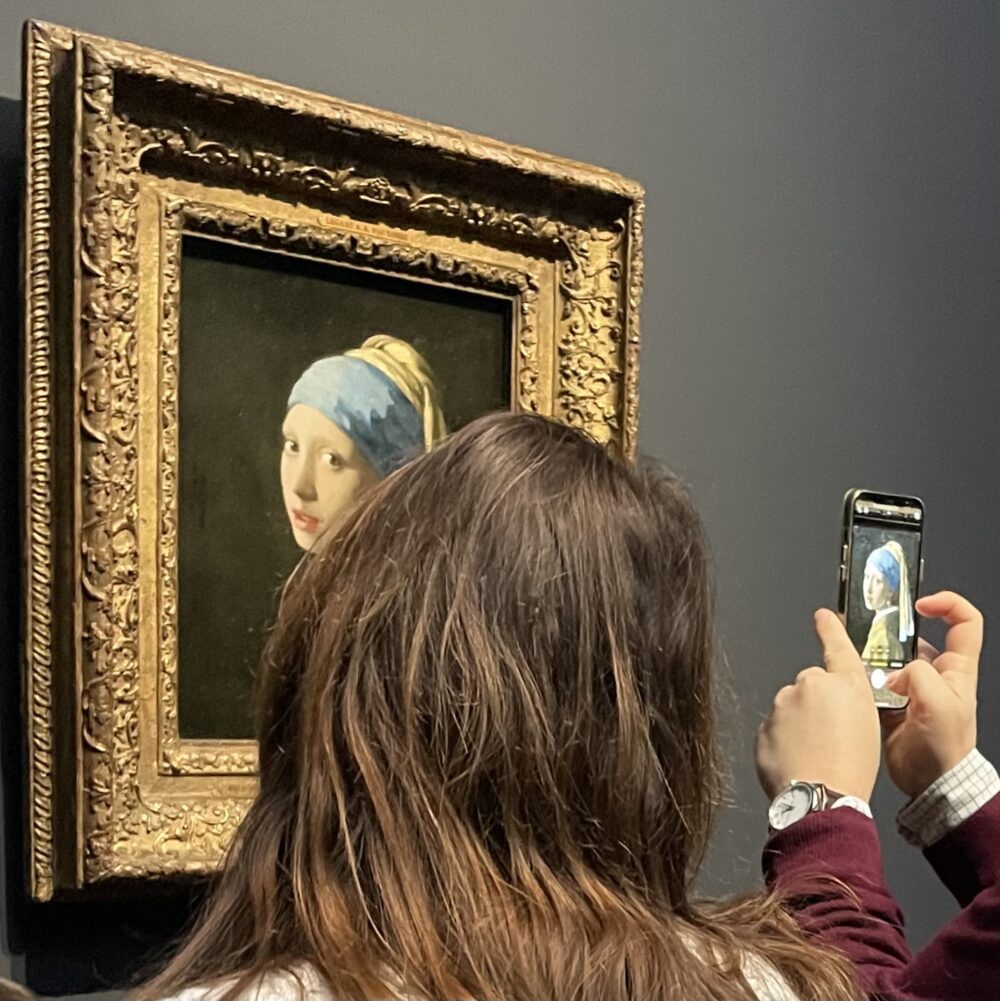
Vermeer was different. I don’t have the knowledge or language to properly explain why, but the experience of seeing these paintings in real life is remarkably different to seeing pictures of them. I think it’s something to do with their vibrancy: there isn’t a hint of dullness in the way there is in many historical paintings. They look, in some ineffable way, as though they are alive, or as though the paint is barely dry.
The exhibition was exceptionally well put together. The curators have avoided any muddying of the experience: there are no paintings by contemporaries for comparison, no works inspired by Vermeer to show his continued legacy, no blown-up reproductions to demonstrate his techniques. This is just the 28 Vermeers, spread across no fewer than ten galleries, giving each room to breathe.
Some paintings are on their own. It is objectively absurd to give The Milkmaid, a painting probably smaller than A3 size, an entire gallery to itself. And yet, it commands the space far more than Rembrandt’s huge Night Watch upstairs.
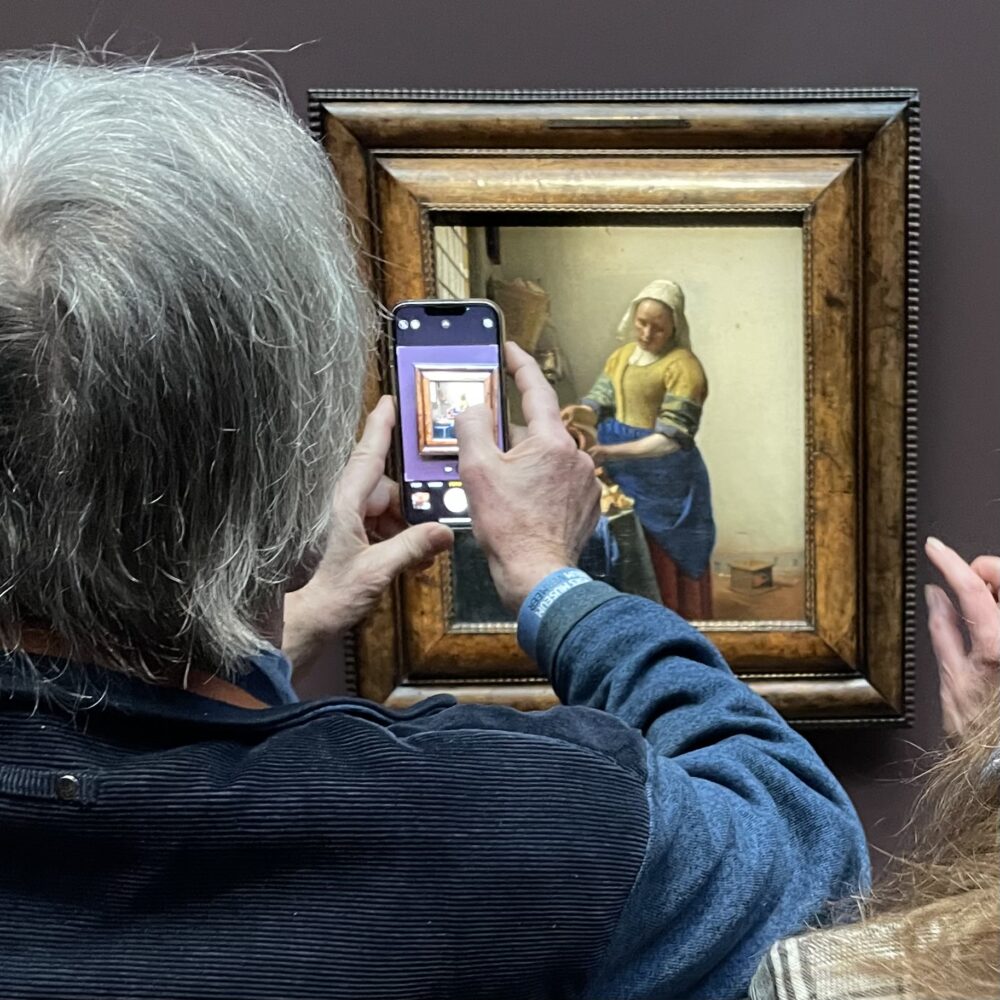
And nowhere in this exhibition does the visitor need to be hindered by bullet-proof glass, ‘which really gives the impression of being very close to the painting.’ Instead, a simple balustrade prevents crowding, but allows leaning over to get a closer look.
But obviously, it’s the paintings that are the star here. That unexpected, indescribable presence, the astounding attention to detail, the lifelike quality. They really are utterly unbelievable, completely astonishing.
I was so unexpectedly bowled over by the exhibition that I did something I’ve never done before with any exhibition: I went back the next day. I was so surprised by the strength of my own reaction that I couldn’t quite believe it, and wondered if I’d just been tired or overawed at being back at the beautiful Rijksmuseum. But no: the paintings really are spectacular, unlike anything I’ve ever seen before.
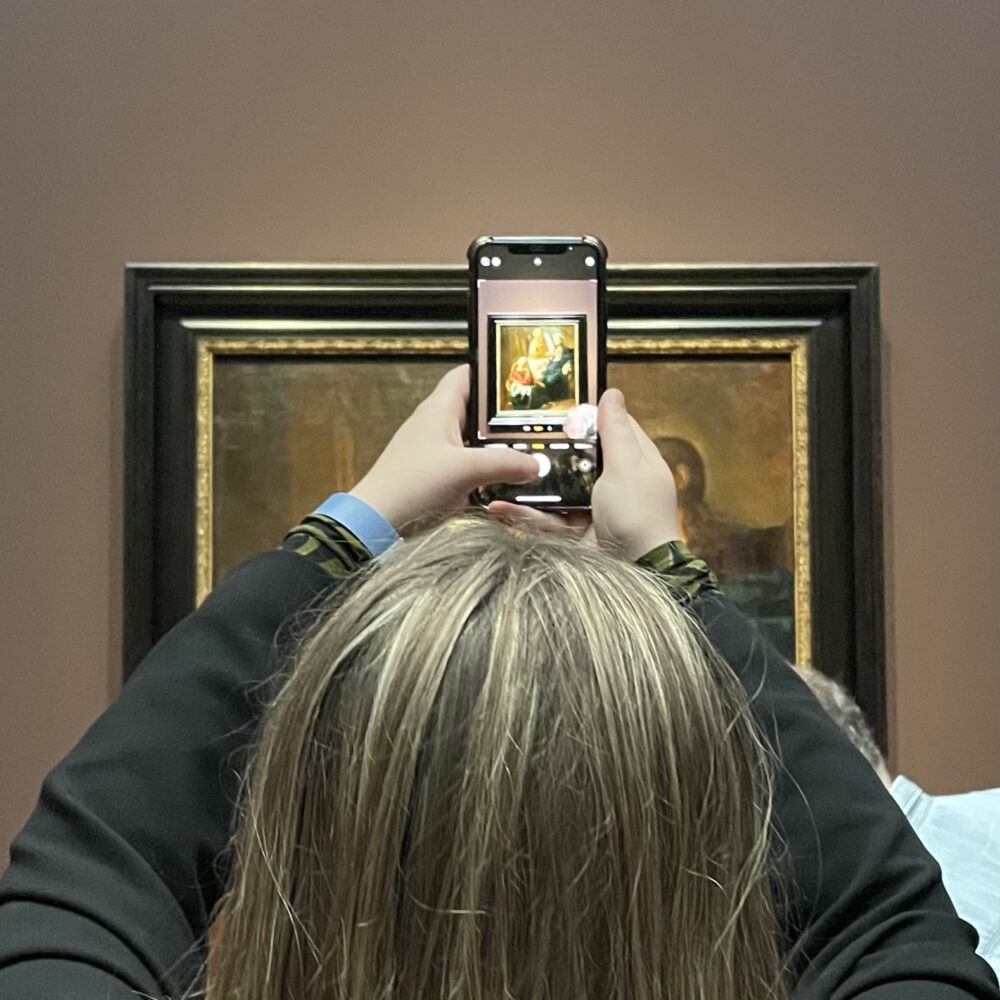
On my second viewing, I decided that the effect was a combination of the fine detail and the light: a lot of Vermeer’s paintings have a clear light source, often a window, and most of the light falls exactly as it would in reality. But there are exceptions: figures within the paintings seem to be lit more brightly than they probably should be. I think it’s this that gives the paintings such an arresting quality, and it most likely works best ‘in person’ because the light sources probably ‘read’ most correctly when the painting is on a wall. I know virtually nothing about painting, so this may well be a load of rubbish–but the fact that I’m spouting it demonstrates how much the Vermeers got inside my head.
Another illustration of how much the paintings struck me is that on my second visit, I bought the catalogue (I never buy the catalogue). And I know this is reaching a whole new standard of weirdness even for me, but the catalogue smells divine–a very intense new book scent. Oh, and the close-ups in it helped to deepen still further my appreciation of Vermeer’s eye for detail.
This exhibition wasn’t at all what I expected when I followed the blue line through the Rijksmuseum to find it: I’m very glad I went to it.
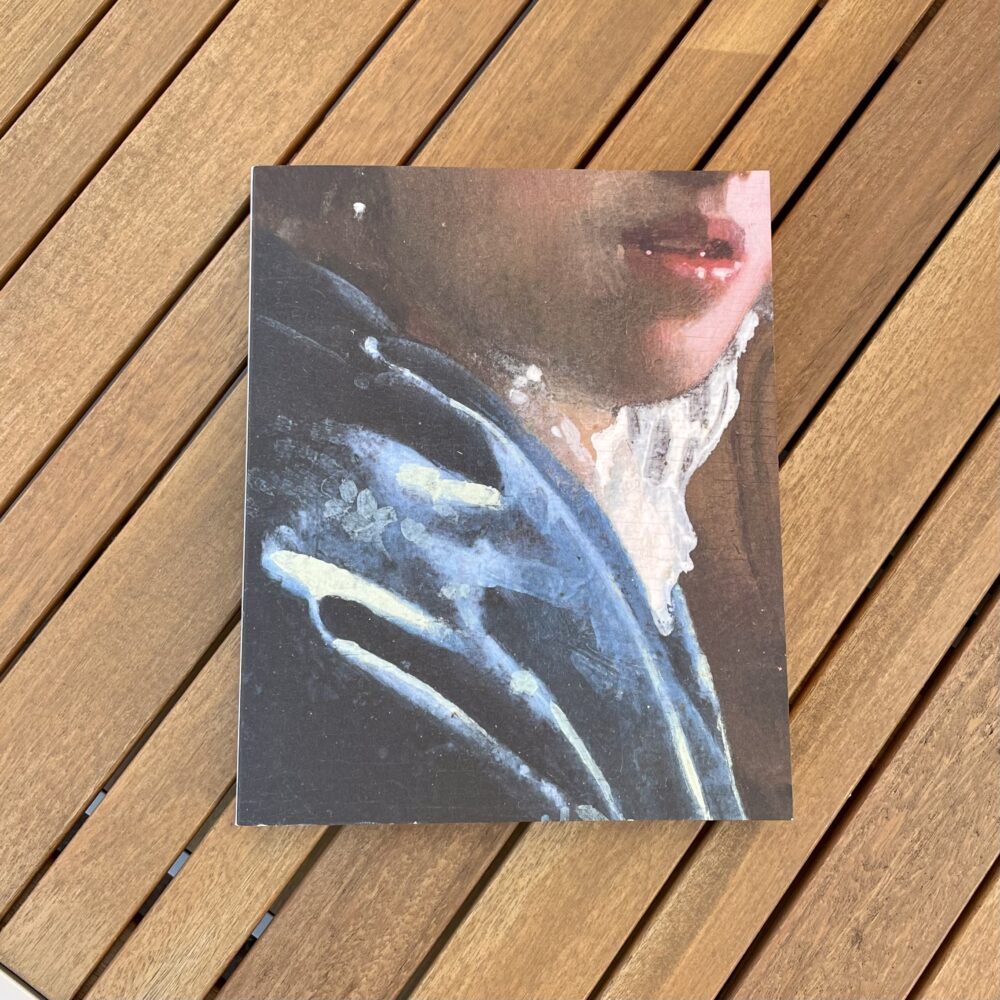
Vermeer continues at the Rijksmuseum until 4 June.
- It is a little bit embarrassing to visit as a Brit, and know that one of the Vermeers missing from this exhibiton is squirreled away in the Royal Collection, not just hidden from visitors to this exhibition, but from everyone. ↩
- My only mention on this blog of seeing the Mona Lisa is a reflection on how many people took selfies with it rather than looking at it, which I think probably underlines my point. ↩
This post was filed under: Art, Post-a-day 2023, Travel, Amsterdam, Rijksmuseum, Vermeer.
A €38m lesson with my latte
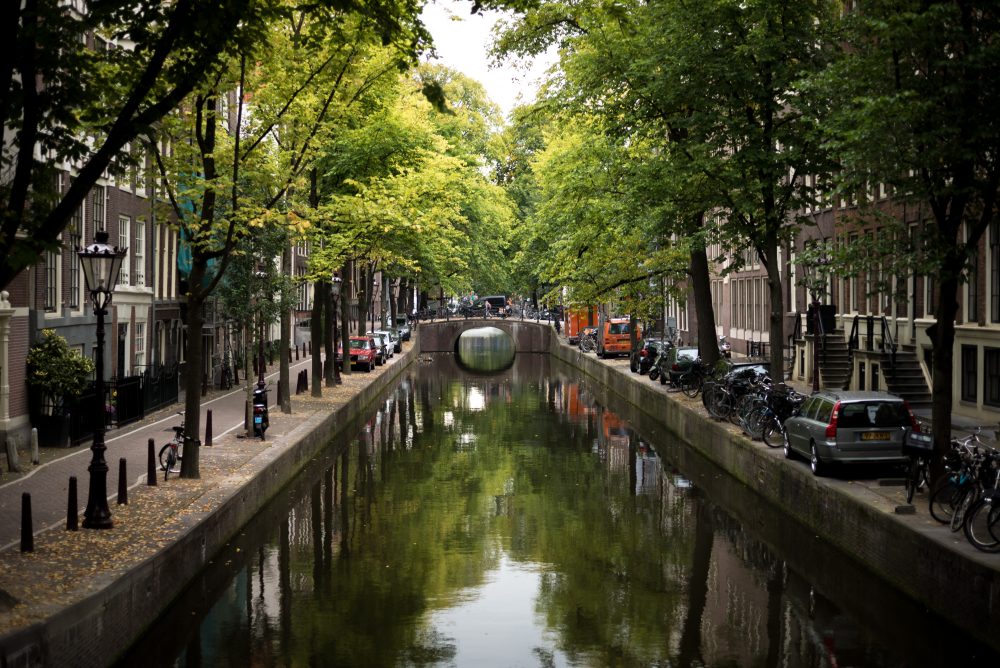
Yesterday, I stopped for a coffee in the lobby of one of Amsterdam’s more upmarket hotels. I settled into a stylish yet surprisingly comfortable armchair next to a wrought iron room divider, and cracked open Fay Weldon’s The Life and Loves of a She Devil. Before I knew it, though, I had stopped reading, and instead tuned in to the intriguing conversation on the other side of the divider.
At a coffee table was a man with a shaved head, who looked of a similar age to me, wearing a white shirt, and a somewhat over-tight unfastened blue suit jacket, pale blue denim jeans, and black suede shoes. Opposite him, with their backs to me, were a man and a woman, each in smartly conservative suits, with leather folios of notes and papers before them. All three were served cappuccinos.
My ears pricked up when the conversation revealed that the man in jeans was confirming and signing the paperwork for a €38m personal loan: that’s not a conversation one hears every day, and not one that I would have expected to hear in such a public place. It turned out that the loan was to fund the purchase of a luxury boat from the man’s father, at below market value as it was partly being offered as a gift. The man intended to use the boat for general recreation, but also had designs on renting it out commercially for cruises, as acquaintances with similar boats were reputedly wont to do.
I know very little about luxury boats. I’ve seen articles in newspapers and magazines about million-pound super-yachts, but I can’t even conceive of what sort of vessel €38m buys you – let alone the full amount including the ‘gift’. I’d believe you if you told me this was a conversation about a four-bedroom yacht that one might sail into a small harbour, and I’d also believe you if you told me this was a conversation about a mini cruise ship with tens of rooms that would require dedicated port facilities. I’ve really no idea. And I’ve also no idea on what sort of terms a €38m personal loan would typically be offered: it’s never a conversation that’s crossed my mind, let alone one that I’m ever likely to take part in (especially if I spend all my money on expensive coffees in posh hotels). And so I was intrigued. Fay Weldon was not going to receive much attention as I sipped this particular latte.
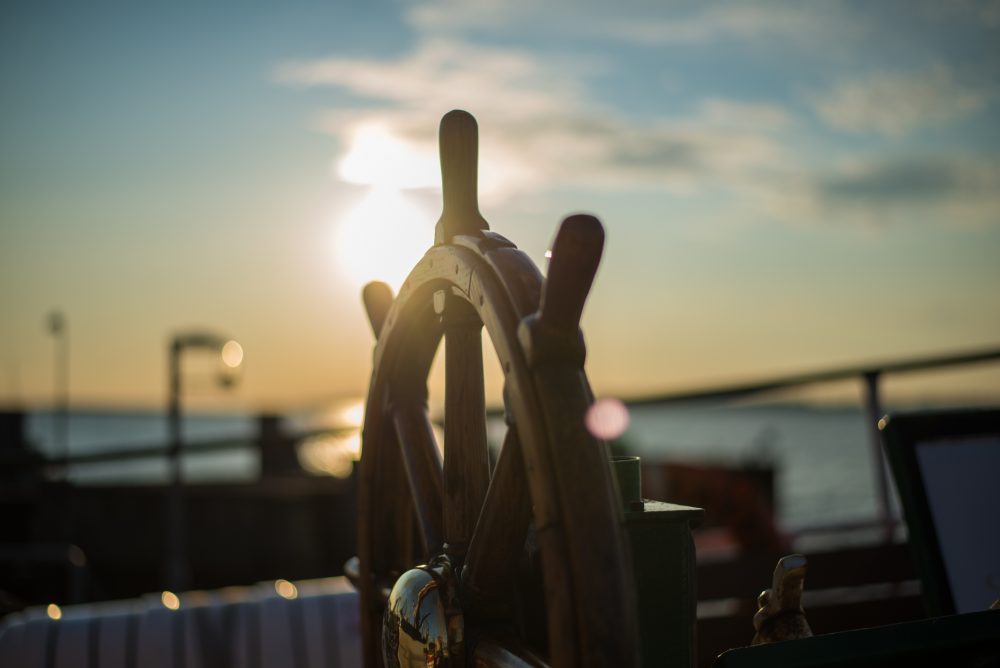
As the conversation progressed, the man in jeans explained that he was confident in the arrangement because he was near certain that his pay cheques would cover the loan repayments whether or not he got round to renting the boat out (goodness only knows what his job was), and if he should fall on hard times, he could sell the boat and easily pay off the loan given that it was for less than the market value. So to this nosey parker, listening through the divider, the deal seemed as sensible as a loan to spend €38m on a boat ever could.
Yet just as he was on the verge of signing the paperwork, the man asked a question which confounded me: “Given that there are no arrangement fees, why are you charging me such as low interest rate?”
The man went onto explain that he was concerned that he had misread the wisdom of the deal. The loan provider had sent two members of staff to meet him in Amsterdam from their offices elsewhere in Europe, at presumably high cost to their firm. The amount of money being borrowed was substantial. The low interest rate meant that the profit they would make on the deal would be small in comparison with the outlay. Why, the man wanted to know, weren’t they pushing for more? Were they expecting that he would default on the loan, and that they would recoup a greater financial prize from the fallout? Were his assumptions about the safety of the deal wrong? What did they know that he didn’t?
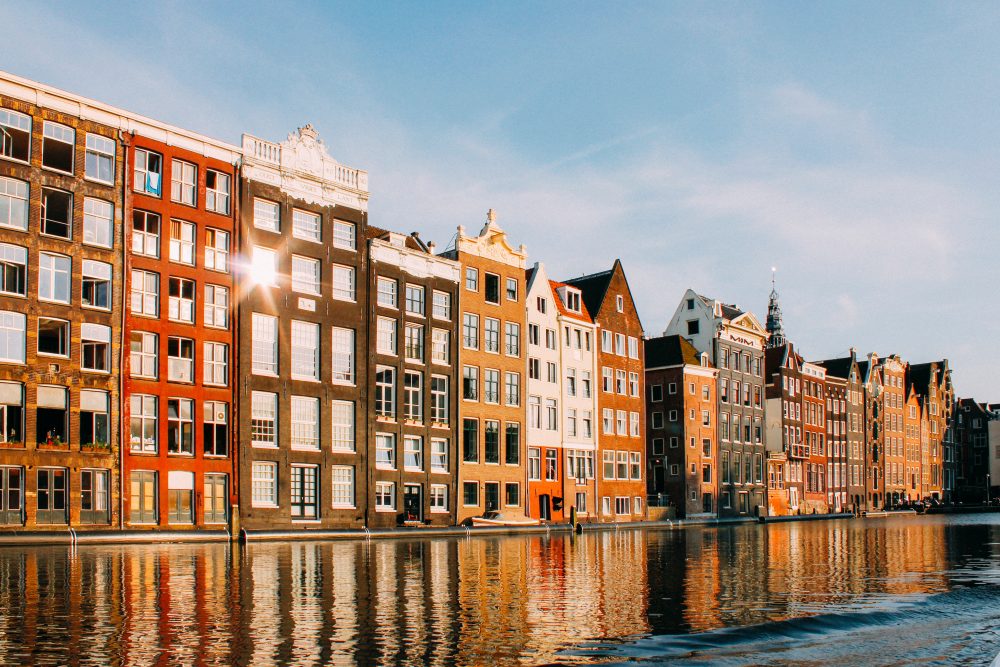
This question confounded me because it’s not common to hear someone clarify the reasons for suspected undercharging. I’m not sure I would have done so—not that I’m ever likely to borrow €38m—because I think I would have been concerned that the lenders would raise their price to meet my expectations.
Yet on my way to Amsterdam, I’d just finished reading Thanks for the Feedback by Douglas Stone and Sheila Heen. This book makes the case that receiving feedback is an interactive process, and we should always seek to understand the point of view of the person giving the feedback. The interest rate on this loan is clearly a type of feedback from the lender.
By discussing the rate with the lenders, the man in jeans could either avoid a huge and costly financial miscalculation on his part, or could set his mind at rest. If the lenders had jacked up the rate in response to his question, he could always have taken his business elsewhere—and, of course, the lenders were unlikely to do so for exactly that reason.
The decision by the man in jeans to have this conversation could have only positive effects: and yet, it is a conversation that I would naturally have shied away from. I suppose, given that he was taking out a €38m loan, the man was probably more used to large scale financial transactions than me. It wouldn’t be an absurd supposition that his day job may be in the financial sector. Perhaps that is why he had he confidence that I would have lacked to initiate this conversation.
But that’s a very easy get-out for myself. What other conversations do I shy away from for illegitimate reasons? Do I avoid asking things that could help prevent me from making unwise decisions because I lack the confidence to ask them? There’s some food for thought and reflection.
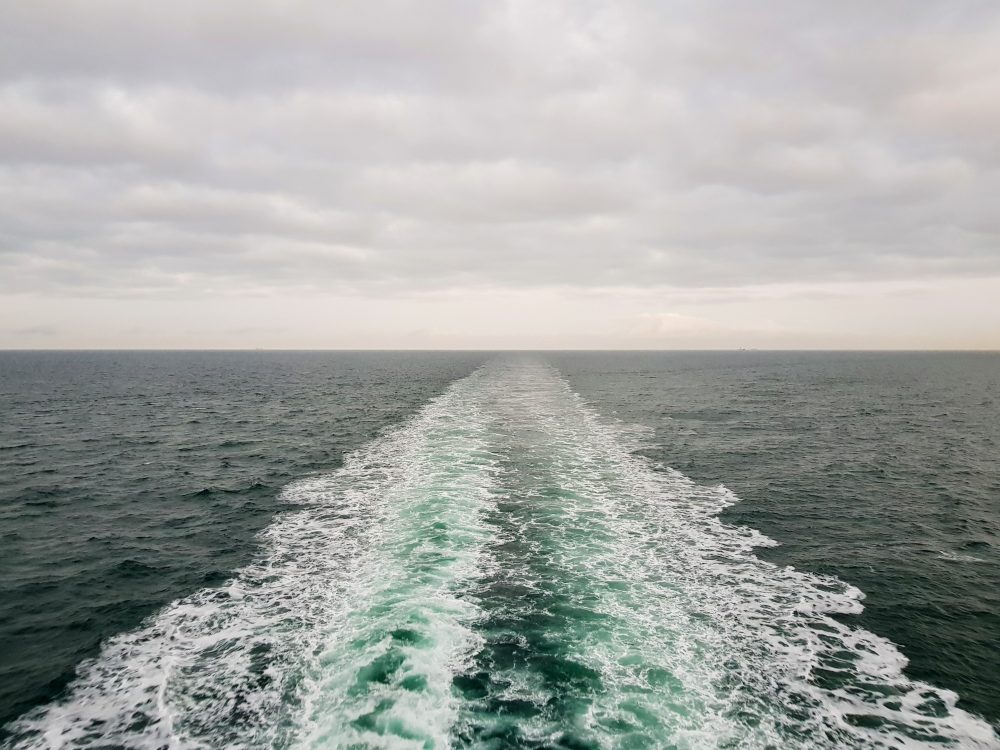
And the answer to the man’s question? Simple, really, according to the lenders. Pricing for loans is risk-based. The loan is secured on the boat which is worth more than the total value of the loan regardless. The terms of the loan state that appropriate insurance must be in place. Even if the man fails to make his repayments, the risk of the lenders not receiving their capital back is very low: such low risk investments for such large amount of money are rare. And besides, even at a low interest rate, the lenders stand to make hundreds of thousands of Euros in pure profit, because a small percentage of a very big number is still a big number.
Before long, the paperwork was duly signed and all three were on their way. The meeting lasted twenty, maybe thirty minutes. If I were one of the lenders, travelling internationally for such a short meting would feel like a waste of time, even though I’d just brought in a huge amount of profit for my firm. But as someone travelling solely for pleasure, I think this was possibly one of the most thought-provoking and educational coffees I’ve sipped in a very long time.
Most of the pictures in this post are not my own, though I did post a nice picture I took at the Rijksmuseum in ‘real time’. In this post, the first picture (Amsterdam) is by Boudewijn “Bo” Boer; the second (a ship’s wheel) is by Maximilian Weisbecker; the third (Amsterdam again) is by Javier M; and the fourth is my own picture of a boat’s wake, co-incidentally taken from the back of the DFDS ferry to Amsterdam (though not on this trip). All are used with grateful thanks, and under the terms of their Creative Commons licences.
This post was filed under: Miscellaneous, Posts delayed by 12 months, Travel, Amsterdam, Finance, Reflection, Travel.
Cruise ships and me
Last week, I read this remarkable story about a new cruise ship by Oli Franklin-Wallis in Wired, and have been thinking about it ever since:
Symphony of the Seas – which, on its maiden voyage from Barcelona in March 2018 became the largest passenger ship ever built – is about five times the size of the Titanic. At 362 metres long, you could balance it on its stern and its bow would tower over all but two of Europe’s tallest skyscrapers. Owned and operated by Miami-based cruise line Royal Caribbean, it can carry nearly 9,000 people and contains more than 40 restaurants and bars; 23 pools, jacuzzis and water slides; two West End-sized theatres; an ice rink; a surf simulator; two climbing walls; a zip line; a fairground carousel; a mini-golf course; a ten-storey fun slide; laser tag; a spa; a gym; a casino; plus dozens more shopping and entertainment opportunities.
Cruise ships mean two things to me.
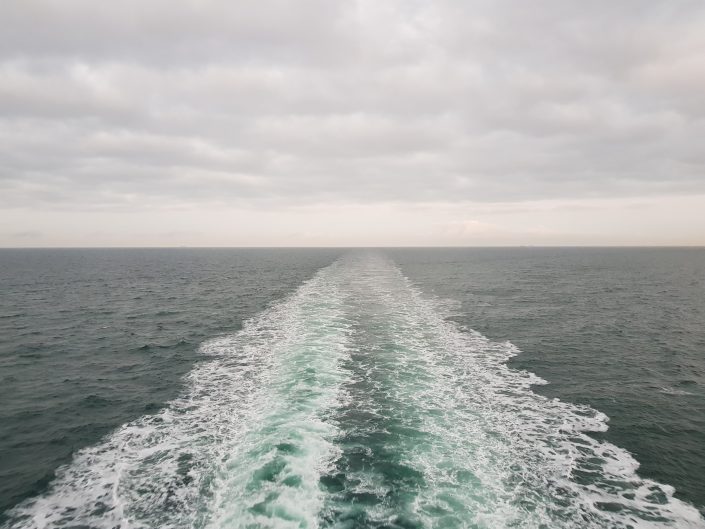
Earlier this year, I went on a ‘mini-cruise’ from Newcastle to Amsterdam aboard a DFDS ship. The journey was an overnight 15 hour or so thing, so certainly not equivalent in any way to spending weeks at sea on the world’s biggest cruise ship. The rationale for this was that I fancied a last-minute break and couldn’t find a cheap flight from Newcastle, so went on a cheap boat instead, spent a day in Amsterdam, and took a cheap flight from there. This worked remarkably well, and I’d do it again.
This was the first time I’d been on an overnight boat since our annual family camping trips to France when I was a child. Prior to going, I’d sort of thought in the back of my mind that I might be the sort of person who might one day enjoy a proper cruise. This experience put me off.
The ship was lovely, and I was particularly impressed by the cabin. I had expected a pokey bunk-bedded hovel but was actually rewarded with a fairly large space which looked not unlike a Travelodge room, with an en-suite bathroom. The food on board was also much higher quality than I would have expected. But I am somebody who likes to wander—and even with only 15 hours on the ship, I was itching to get off and explore. Exploring the ship felt a bit constrained.
It was silly of me not to realise this in the first place. Wendy and I ruled out going to an idyllic holiday resort last summer for the sole reason that it was located on a main road along which walking was not advised, so we couldn’t ‘go for a wander’ without catching a bus or taxi somewhere first. I hadn’t really clocked that ‘going for a wander’ wasn’t really a go-er on a ship.
While the Symphony of the Seas is ridiculously bigger than the ship I was on (it’s more than twice as long and can take four times as many passengers across twice as many decks), I still think I’d feel ‘cooped up’ pretty quickly. So I don’t think I’ll be going cruising anytime soon.
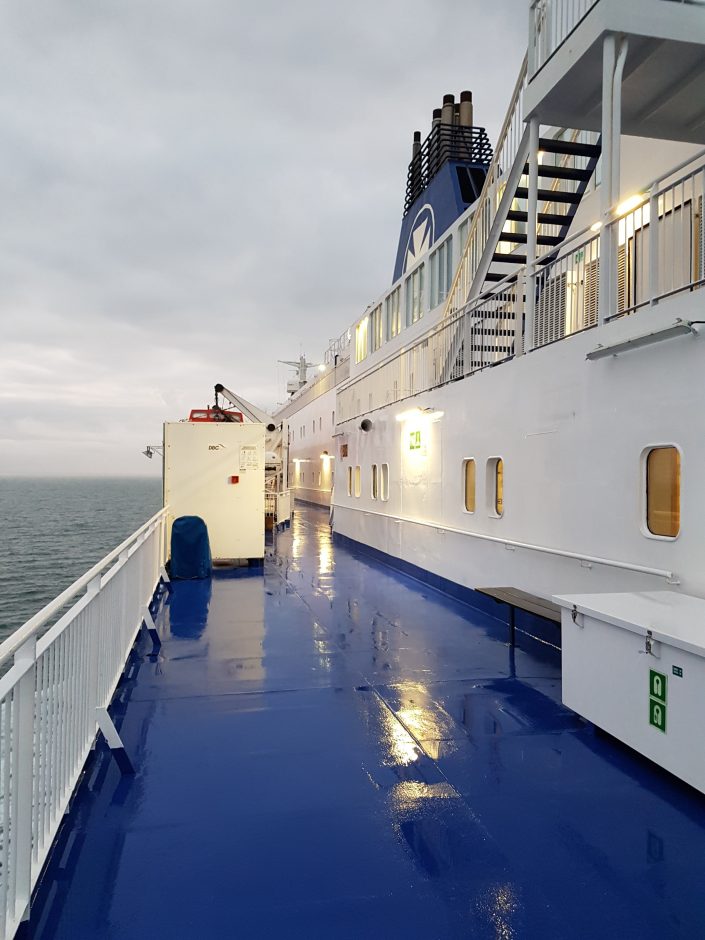
My other relationship with ships is professional. One of the more esoteric parts of my role as a Consultant in Health Protection is that I am the designated Medical Officer for a number of ports. This gives me certain legal responsibilities relating to ships and the health of their crew—most of which are thankfully delegated to people much more expert than me. But just imagine how complex an outbreak of norovirus or Legionnaire’s disease could get on a ship as huge as Symphony of the Seas. I was fascinated to read in Oli’s article about some of the steps taken to mitigate the risks:
“The level of hygiene is extreme,” Yrjovuori announced, as we passed a hand-washing station. Though ship-wide outbreaks of sickness make the news at least once a year, the total number of passengers who fall ill is a fraction of one per cent. But close quarters enable outbreaks, so sanitation regulations at sea are stringent. Every part of the ship, from lift buttons to the casino’s chips, are sanitised daily; interior materials have to stand up to the high level of chlorination from the constant cleaning. Rubbish is frozen in vast storage containers to slow bacteria growth and is only removed in port.
Fascinating stuff… perhaps we could even try and replicate some of it on land!
The pictures in this post are my own from the above-described ‘mini-cruise’ adventure. The pictures in the Wired article are a great advert for the power of print, looking far more arresting as double-page spreads than as on-screen images.
This post was filed under: Health, Posts delayed by 12 months, Travel, Amsterdam, Cruises, DFDS, Newcastle upon Tyne, Port Health, Public Health, Ships, Travel.
